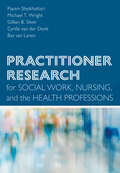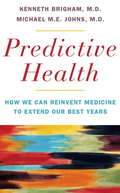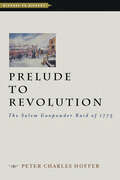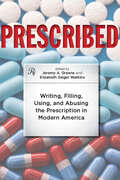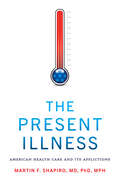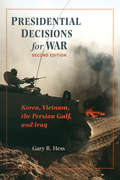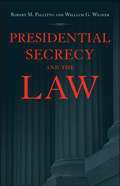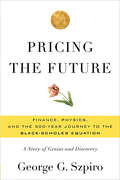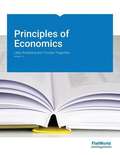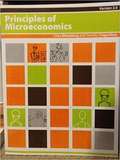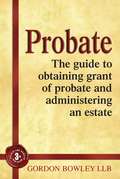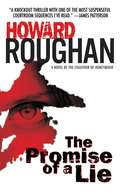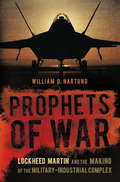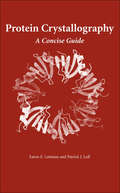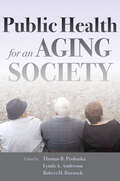- Table View
- List View
Practitioner Research for Social Work, Nursing, and the Health Professions
by Michael T. Wright Payam Sheikhattari Gillian B. Silver Cyrilla van der Donk Bas van LanenAn invaluable tool for health and social work students and professionals who want to improve their practice through collaborative research with patients, clients, and colleagues.Throughout history, some of the most prominent contributors to health and social sciences have been men and women comfortable with both practice and academia. But today, research in health-related fields is increasingly conducted in specialized settings by people who are first and foremost researchers. Critics bemoan this loss of practice-based research, long considered a vital part of the contribution that doctors, nurses, public health workers, and social workers can make both to their field and the communities in which they work. Unfortunately, the explosion of new discoveries in health-related fields, along with the exponential increase in the amount of knowledge being produced and the growing demands of practice, have caused both the production and application of knowledge to become highly specialized and increasingly complex. This has resulted in a widening gap between research and practice.Recognizing the need for a guide to this type of research, Practitioner Research for Social Work, Nursing, and the Health Professions is a thoroughly reimagined version of a book originally published in 2011 in the Netherlands. Aimed at American practitioners, it is a highly practical guide for anyone in social work, nursing, and other health care and social welfare settings. Its seven-step Practitioner Research Method offers readers a tried-and-true approach to conducting research in their own work environments, and the authors use real-world examples to highlight strategies for overcoming barriers and incorporating research.While leading practitioners through each stage of the research process, the authors explain in detail how to apply a variety of field-tested tools and techniques. A unique and indispensable resource for students in undergraduate and graduate research courses, as well as for seasoned professionals who seek a practical guide for developing and implementing their own research projects in social work, nursing, and the health professions, this book is also the first textbook to introduce the concept and practice of practitioner research to an American audience.
Predictive Health: How We Can Reinvent Medicine to Extend Our Best Years
by Kenneth L. Brigham Michael M. JohnsOur health care system is crippled by desperate efforts to prevent the inevitable. A third of the national Medicare budget—nearly 175 billion—is spent on the final year of life, and a third of that amount on the final month, often on expensive (and futile) treatments. Such efforts betray a fundamental flaw in how we think about healthcare: we squander resources on hopeless situations, instead of using them to actually improve health.In Predictive Health, distinguished doctors Kenneth Brigham and Michael M.E. Johns propose a solution: invest earlier—and use science and technology to make healthcare more available and affordable. Every child would begin life with a post-natal genetic screen, when potential risk—say for type II diabetes or heart disease—would be found. More data on biology, behavior, and environment would be captured throughout her life. Using this information, health-care workers and the people they care for could forge personal strategies for healthier living long before a small glitch blows up into major disease. This real health care wouldn&’t just replace much of modern disease care—it would make it obsolete. The result, according to Brigham and Johns, will be a life defined by a long stay at top physical and mental form, rather than an early peak and long decline. Accomplishing this goal will require new tools, new clinics, fewer doctors and more mentors, smarter companies, and engaged patients. In short, it will require a revolution. Thanks to a decade-long collaboration between Brigham, Johns and others, it is already underway.An optimistic plan for reducing or eliminating many chronic diseases as well as reforming our faltering medical system, Predictive Health is a deeply knowledgeable, deeply humane proposal for how we can reallocate expenses and resources to prolong the best years of life, rather than extending the worst.
Prelude to Revolution: The Salem Gunpowder Raid of 1775 (Witness to History)
by Peter Charles HofferBefore colonial Americans could declare independence, they had to undergo a change of heart. Beyond a desire to rebel against British mercantile and fiscal policies, they had to believe that they could stand up to the fully armed British soldier. Prelude to Revolution uncovers one story of how the Americans found that confidence.On April 19, 1775, British raids on Lexington Green and Concord Bridge made history, but it was an episode nearly two months earlier in Salem, Massachusetts, that set the stage for the hostilities. Peter Charles Hoffer has discovered records and newspaper accounts of a British gunpowder raid on Salem. Seeking powder and cannon hidden in the town, a regiment of British Regulars were foiled by quick-witted patriots who carried off the ordnance and then openly taunted the Regulars. The prudence of British commanding officer Alexander Leslie and the persistence of the patriot leaders turned a standoff into a bloodless triumph for the colonists. What might have been a violent confrontation turned into a local victory, and the patriots gloated as news spread of "Leslie’s Retreat."When British troops marched on Lexington and Concord on that pivotal day in April, Hoffer explains, each side had drawn diametrically opposed lessons from the Salem raid. It emboldened the rebels to stand fast and infuriated the British, who vowed never again to back down. After relating these battles in vivid detail, Hoffer provides a teachable problem in historic memory by asking why we celebrate Lexington and Concord but not Salem and why New Englanders recalled the events at Salem but then forgot their significance.Praise for the work of Peter Charles Hoffer"This book more than succeeds in achieving its goal of helping students understand and appreciate the cultural and intellectual environment of the Anglophone world."—New England Quarterly, reviewing When Benjamin Franklin Met the Reverend Whitefield"A synthetic essay of considerable grace and scope... An excellent overview of the field."—Journal of Legal History, reviewing Law and People in Colonial America
Prescribed: Writing, Filling, Using, and Abusing the Prescription in Modern America
by Elizabeth Siegel Watkins Jeremy A. GreeneAmerica has had a long love affair with the prescription. It is much more than the written "script" or a manufactured medicine, professionally dispensed and taken, and worth hundreds of millions of dollars a year. As an object, it is uniquely illustrative of the complex relations among the producers, providers, and consumers of medicine in modern America. The tale of the prescription is one of constant struggles over and changes in medical and therapeutic authority. Stakeholders across the biomedical enterprise have alternately upheld and resisted, supported and critiqued, and subverted and transformed the power of the prescription. Who prescribes? What do they prescribe? How do they decide what to prescribe? These questions set a society-wide agenda that changes with the times and profoundly shifts the medical landscape. Examining drugs individually, as classes, and as part of the social geography of health care, contributors to this volume explore the history of prescribing, including over-the-counter contraceptives, the patient’s experience of filling opioid prescriptions, restraints on physician autonomy in prescribing antibiotics, the patient package insert, and other regulatory issues in medicine during postwar America.The first authoritative look at the history of the prescription itself, Prescribed is a groundbreaking book that subtly explores the politics of therapeutic authority and the relations between knowledge and practice in modern medicine.
The Present Illness: American Health Care and Its Afflictions
by Martin F. ShapiroBeyond political posturing and industry quick-fixes, why is the American health care system so difficult to reform?Health care reform efforts are difficult to achieve and have been historically undermined by their narrow scope. In The Present Illness, Martin F. Shapiro, MD, PhD, MPH, weaves together history, sociology, extensive research, and his own experiences as a physician to explore the broad range of afflictions impairing US health care and explains why we won't be able to fix the system without making significant changes across society. With a sharp eye and ready humor, Shapiro dissects the ways all groups participating—clinicians and their organizations, medical schools and their faculty, hospitals and clinical corporations, scientists and the National Institutes of Health, insurers and manufacturers, governments and their policies, and also patients and the public—shape and reinforce a dysfunctional system. Shapiro identifies three major problems stymieing reform: commodification of care; values, expectations, unmet needs, attitudes, and personal limitations of participants; and toxic relationships and communication among these groups.Shapiro lays out a sweeping agenda of concrete actions to address the many factors contributing to the system's failings. Highlighting the interconnectedness of both the problems and potential solutions, he warns that piecemeal reform efforts will continue to be undermined by those who believe they have something to gain from the status quo. Although overhauling our health care system is daunting, Shapiro nonetheless concludes that we must push forward with a far more comprehensive effort in all sectors of health care and throughout society to create a system that is humane, effective, and just.
The Present Illness: American Health Care and Its Afflictions
by Martin F. ShapiroBeyond political posturing and industry quick-fixes, why is the American health care system so difficult to reform?Health care reform efforts are difficult to achieve and have been historically undermined by their narrow scope. In The Present Illness, Martin F. Shapiro, MD, PhD, MPH, weaves together history, sociology, extensive research, and his own experiences as a physician to explore the broad range of afflictions impairing US health care and explains why we won't be able to fix the system without making significant changes across society. With a sharp eye and ready humor, Shapiro dissects the ways all groups participating—clinicians and their organizations, medical schools and their faculty, hospitals and clinical corporations, scientists and the National Institutes of Health, insurers and manufacturers, governments and their policies, and also patients and the public—shape and reinforce a dysfunctional system. Shapiro identifies three major problems stymieing reform: commodification of care; values, expectations, unmet needs, attitudes, and personal limitations of participants; and toxic relationships and communication among these groups.Shapiro lays out a sweeping agenda of concrete actions to address the many factors contributing to the system's failings. Highlighting the interconnectedness of both the problems and potential solutions, he warns that piecemeal reform efforts will continue to be undermined by those who believe they have something to gain from the status quo. Although overhauling our health care system is daunting, Shapiro nonetheless concludes that we must push forward with a far more comprehensive effort in all sectors of health care and throughout society to create a system that is humane, effective, and just.
Presidential Decisions for War: Korea, Vietnam, the Persian Gulf, and Iraq (The American Moment)
by Gary R. HessFollowing World War II, Americans expected that the United States would wage another major war against a superpower. Instead, the nation has fought limited wars against much weaker states, such as North Korea, North Vietnam, and Iraq. This revised and updated edition of Presidential Decisions for War analyzes the means by which four presidents have taken the nation to war and assesses the effectiveness of each president's leadership during those conflicts. Gary Hess recreates the unfolding crises in Korea, Vietnam, and Iraq to probe the reasons why Presidents Truman, Johnson, George H. W. Bush, and George W. Bush and their advisors decided in favor of war. He compares the performance of the commanders-in-chief and evaluates how effectively each understood U.S. interests, explored alternatives to war, adhered to constitutional processes, and built congressional, popular, and international support. A new conclusion points out, that unlike the administrations of Truman, Johnson, and the elder Bush, George W. Bush's White House actively sought to change the international order through preemptive war and aggressive democracy building. Fully revised and featuring an examination of how each of the presidents learned from history and juggled the demands on diplomacy, this comparative study of presidential war-making elucidates how effective executive leadership—or its absence—directly affects the outcome of wars.
Presidential Secrecy and the Law
by Robert M. Pallitto William G. WeaverAs seen on The Daily Show, July 24State secrets, warrantless investigations and wiretaps, signing statements, executive privilege—the executive branch wields many tools for secrecy. Since the middle of the twentieth century, presidents have used myriad tactics to expand and maintain a level of executive branch power unprecedented in this nation’s history. Most people believe that some degree of governmental secrecy is necessary. But how much is too much? At what point does withholding information from Congress, the courts, and citizens abuse the public trust? How does the nation reclaim rights that have been controlled by one branch of government?With Presidential Secrecy and the Law, Robert M. Pallitto and William G. Weaver attempt to answer these questions by examining the history of executive branch efforts to consolidate power through information control. They find the nation’s democracy damaged and its Constitution corrupted by staunch information suppression, a process accelerated when "black sites," "enemy combatants," and "ghost detainees" were added to the vernacular following the September 11, 2001, terror strikes.Tracing the current constitutional dilemma from the days of the imperial presidency to the unitary executive embraced by the administration of George W. Bush, Pallitto and Weaver reveal an alarming erosion of the balance of power. Presidential Secrecy and the Law will be the standard in presidential powers studies for years to come.
Pricing the Future: Finance, Physics, and the 300-year Journey to the Black-Scholes Equation
by George G. SzpiroOptions have been traded for hundreds of years, but investment decisions were based on gut feelings until the Nobel Prize-winning discovery of the Black-Scholes options pricing model in 1973 ushered in the era of the "quants.” Wall Street would never be the same. In Pricing the Future, financial economist George G. Szpiro tells the fascinating stories of the pioneers of mathematical finance who conducted the search for the elusive options pricing formula. From the broker's assistant who published the first mathematical explanation of financial markets to Albert Einstein and other scientists who looked for a way to explain the movement of atoms and molecules, Pricing the Future retraces the historical and intellectual developments that ultimately led to the widespread use of mathematical models to drive investment strategies on Wall Street.
Principles of Economics v 1.1
by Libby Rittenberg Timothy TregarthenVersion 1.1 boasts improved coverage throughout the text including significant updates to: Chapters 20 (GDP, Price Level Changes, Business Cycles, and Unemployment) Chapter 21 (Measuring Total Output and Income) Chapter 27 (Government and Fiscal Policy) Chapter 32 (Macroeconomics for the 21st Century).
Principles of Economics Version 2.0
by Libby Rittenberg Timothy TregarthenIn the macro chapters of Version 2.0 of Principles of Economics thoroughly incorporates the recent recession and recovery-- placing it in historical and theoretical context and not shying away from the controversies surrounding how government responded to it. In the micro chapters, all the time-sensitive data has been updated, along with over half of all the "Start Ups" and "Case and Point" applications being brand new or updated. Flat World Knowledge is thrilled to publish a re-launch of Tim Tregarthen's acclaimed Principles of Economics V. 2.0 book, and proud to bring Tim's remarkable talents as a teacher to future generations of students.
Principles of Macroeconomics
by Libby Rittenberg Timothy TregarthenFlat World Knowledge is honored to publish a new, first edition re-launch of Tim Tregarthen's wonderful principles of macroeconomics book, and proud to bring Tim's incredible talents as a teacher back to life so future generations of students can continue to learn from him. In 1996, he published the first edition of his principles of microeconomics textbook to great acclaim, and it became widely used in colleges around the country. That same year, MS made him wheelchair-bound. The disease forced his retirement from teaching at the University of Colorado at Colorado Springs in 1998. He lost the use of his arms in 2001 and has been quadriplegic ever since. Tim never let his disease get him down. In fact, he turned back to his love of writing and teaching for inspiration. He obtained a voice-activated computer, recruited a co-author, Libby Rittenberg of Colorado College, and turned his attention to revising his principles of economics book. Today we are excited to introduce Libby Rittenberg and Timothy Tregarthen's Principles of Macroeconomics. The authors teach economics as the study of "choice " by providing students with an accessible, straightforward overview of economics. This text combines the clarity and writing of Tregarthen's seminal periodical "The Margin" with great teaching insights. Rittenberg and Tregarthen help students to understand how real individuals actually work with economics. In this new book, the authors illustrate the practicality and relevance of economics with a variety of new illustrations and insights. The authors take a three-pronged approach to every concept: (1) the concept is covered with a "Heads Up" to ward off confusion, (2) a "You Try It" section makes sure students are staying on top of the concept and (3) a "Case and Point" section that uses a real-world application to harness the concept in reality. For one example of how this plays out in the text see "Chapter 3, Section 2 on Supply".here This book is intended for a one-semester course in Macroeconomics taught out the social sciences or business school.
Principles of Management
by Mason Carpenter Talya Bauer Berrin ErdoganPrinciples of Management by Carpenter, Bauer and Erdogan teaches management principles to tomorrow's business leaders by weaving three threads through every chapter: strategy, entrepreneurship and active leadership. Strategic: All business school teachings have some orientation toward performance and strategy and are concerned with making choices that lead to high performance. Principles of Management will frame performance using the notion of the triple bottom-line the idea that economic performance allows individuals and organizations to perform positively in social and environmental ways as well. The triple bottom line is financial, social, and environmental performance. It is important for all students to understand the interdependence of these three facets of organizational performance. The Entrepreneurial Manager: While the General Management course at Harvard Business School was historically one of its most popular and impactful courses (pioneered in the 1960s by Joe Bower), recent Harvard MBAs did not see themselves as general managers. This course was relabeled 'The Entrepreneurial Manager' in 2006, and has regained its title as one of the most popular courses. This reflects and underlying and growing trend that students, including the undergraduates this book targets, can see themselves as entrepreneurs and active change agents, but not just as managers. By starting fresh with an entrepreneurial/change management orientation, this text provides an exciting perspective on the art of management that students can relate to. At the same time, this perspective is as relevant to existing for-profit organizations (in the form intrapreneurship) as it is to not-for-profits and new entrepreneurial ventures. Active Leadership: Starting with the opening chapter, Principles of Management show students how leaders and leadership are essential to personal and organizational effectiveness and effective organizational change. Students are increasingly active as leaders at an early age, and are sometimes painfully aware of the leadership failings they see in public and private organizations. It is the leader and leadership that combine the principles of management (the artist's palette, tools, and techniques) to create the art of management. Cases: Mason provides brief cases in his Instructors Manual for those who take a case approach to the course or who wish to incorporate cases. This book's modular format easily maps to a POLC course organization (Planning, Organizing, Leading, and Controlling, attributed to Henri Fayol (1949, General and industrial management. London. Pitman Publishing company), and suits the needs of most undergraduate or graduate course in Principles of Management.
Principles of Marketing 2.0
by Mary Anne Raymond Jeff TannerPrinciples of Marketing Version 2.0 by Tanner, Raymond and Schuster teaches the experience and process of actually doing marketing - not just the vocabulary. It carries five dominant themes throughout in order to expose students to marketing in today's environment: Service dominant logic - This textbook employs the term "offering" instead of the more traditional First "P" -- product. That is because consumers don't sacrifice value when alternating between a product and a service. They are evaluating the entire experience, whether they interact with a product, a service, or a combination. So the fundamental focus is providing value throughout the value chain, whether that value chain encompasses a product, service, or both. Sustainability; Increasingly, companies are interested in the impact they are having on their local community as well as the overall environment. This is often referred to as the triple bottom line of financial, social, and environment performance. Ethics and social responsibility; Following on the sustainability notion is the broader importance of ethics and social responsibility in creating successful organizations. The authors make consistent references to ethical situations throughout chapter coverage, and end of chapter material in most chapters will encompass ethical situations. Global coverage -- Tanner, Raymond and Schuster deliberately entitled Chapter 1; What is Marketing?; Whether it is today's price of gasoline, the current U.S. presidential race, or Midwestern U.S. farming, almost every industry and company needs strong global awareness. And today's marketing professionals must understand the world in which they and their companies operate. Metrics -- Firms today have the potential to gather more information than ever before about their current and potential customers. That information gathering can be costly, but it can also be very revealing. With the potential to capture so much more detail about micro transactions, firms should now be more able to answer ;well, what this marketing strategy really worth it?; And what is the marketing ROI?; And finally, what is this customer or set of customers worth to us over their lifetime? Principles of Marketing Version 2.0 brings new and updated coverage of new developments in the influence of social media to empower consumers, as well as marketing's use of social media, such as sentiment analysis, mobile marketing, and customer service and complaint tracking, as a communications and promotion channel, just a name a few. Version 2.0 also has an overall increased number of examples, as well as, new discussion questions in every chapter (resulting in at least 10 per chapter). In addition, the textbook's key terms, and repeated concepts have been strategically arranged to make customizing this book with Flat World's MIYO platform even easier.
Principles of Microeconomics 2.0
by Libby Rittenberg Timothy TregarthenFlat World Knowledge is honored to publish Version 2.0 (an orginal re-launch) of Tim Tregarthen's wonderful principles of microeconomics book, and proud to bring Tim's incredible talents as a teacher back to life so future generations of students can continue to learn from him.
Probate: A Self-help Guide
by Gordon BowleyThe majority of applications for probate that follow someone's death can be dealt with inexpensively by any reasonably intelligent person with time available and a little guidance. This easy-to-follow book clearly explains all the information you need to administer the deceased's estate; from dealing with the urgent practical matters to preparing and submitting the relevant forms, paying inheritance tax, and distributing the estate. You'll find specimen forms and letters and a list of useful addresses that will enable you to deal with it all yourself.
Professor Stewart's Hoard of Mathematical Treasures: Another Drawer From The Cabinet Of Curiosities
by Ian StewartOpening another drawer in his Cabinet of Curiosities, renowned mathematics professor Ian Stewart presents a new medley of games, paradoxes, and riddles in Professor Stewart's Hoard of Mathematical Treasures. With wit and aplomb, Stewart mingles casual puzzles with grander forays into ancient and modern mathematical thought.Amongst a host of arcane and astonishing facts about every kind of number from irrational and imaginary to complex and cuneiform, we learn: How to organize chaosHow matter balances anti-matterHow to turn a sphere inside out (without creasing it) How to calculate pi by observing the stars...and why you can't comb a hairy ball.Along the way Stewart offers the reader tantalizing glimpses of the mathematics underlying life and the universe. Mind-stretching, enlightening, and endlessly amusing, Professor Stewart's Hoard of Mathematical Treasures will stimulate, delight, and enthrall.
Project Kid: 60 Imaginative Projects That Fly, Sail, Race, and Dive
by Amanda KingloffThomas the Tank Engine. Hot Wheels. Mike Mulligan and His Steam Shovel. Richard Scarry&’s Cars and Trucks and Things That Go. Kids&’ fascination with vehicles is insatiable. In Project Kid: Crafts That Go!, that excitement is translated into more than 60 inventive craft projects for parents to make with and for their children. The book is organized into seven chapters: City, Rails, Sky, Space, Water, Country, and Dirt. There are police cars and ice cream trucks; circus trains and submarines; helicopters, rocket ships, cement mixers, and school buses. And because the car-obsessed kid doesn&’t just want a new vehicle to play with—he wants a racetrack, his very own driver&’s license, maybe even a child-sized gas station—each chapter includes not only toys but also thematic clothing, decor, accessories, and more. Projects feature clear instructions and step-by-step photographs wherever they are needed, easy for both kids and non-crafty adults to understand.
The Promise of a Lie
by Howard RoughanHoward Roughan?s debut, The Up and Comer, was hailed as one of the most hip and entertaining thrillers of the year. Now Roughan returns at full stride with a scintillating novel of deception that begins when a gifted young psychologist becomes entangled in the life of a beautiful and calculating patient. Nothing can prepare Dr. David Remler for the shocking phone call he receives from a patient named Samantha Kent. Stunned and anxious to help, he rushes out into the Manhattan night to keep a bloody act of violence from spinning further out of control. He knows he is too involved, that he?s crossed a line, and that his professional reputation is at stake. But he has no idea what awaits him at his destination...that he?s become a pawn in a very deadly game of revenge. Suddenly the focus of a criminal case that flares into an out-of-control media circus, David has only one shot to clear his name. But first he has to clear up the mystery of his patient, - Samantha Kent. Just who is she? And why did she choose to involve David? Little by little, the outlines of a brilliant plot emerge - and, with it, the horrifying power of a single lie - In this richly textured tale of a man?s battle against the mother of all manipulations, the perfect setup is even more diabolical than it looks.
Promposal
by RaeChell GarrettAn overachiever must decide if risking her heart by working with her former crush turned enemy is worth the reward in this snappy rom-com, perfect for fans of Tweet Cute and The Upside of Falling. High school senior Autumn Reeves has been waitlisted at her dream school. Determined to move to the top of the list, she must find a way to stand out. When a promposal she planned for a friend has half the senior class asking for her help, a brilliant business idea that will look great on her application is born: Promposal Queen. Autumn has no clue how to start a business, so she joins the Young Black Entrepreneurs group and finds herself face-to-face with Mekhi Winston, the boy whose unexpected freshman-year kiss—a kiss that meant everything to her and nothing to him—cost Autumn her best friend. He&’s the only person with the experience to help her, but how can she possibly trust him? With her dreams on the line, Autumn&’s willing to risk it. After all, Mekhi could be a good business partner without being a guy she would ever let near her heart again. But when working with Mekhi jeopardizes her only chance at rekindling a friendship with her ex-best-friend, and secrets long buried threaten to ruin Promposal Queen, another broken heart may be the least of her worries--her entire future is on the line.
Property Investment: How to use property to achieve financial freedom and security (Tom Thorne Novels #270)
by Samantha CollettThis inspirational book contains the guiding principles to help you become a successful property investor. Whether you want to invest in buy-to-let, have a go at some development projects, or take a calculated risk on some speculative opportunities you can succeed if you follow the essential rules in this book. You will discover how to:· Think, act and live like a successful property investor· Develop the skills needed to identify potential opportunities · Undertake buy-to-let and refurbishment projects which make money · Develop the techniques and skills you need to manage the cash flows· Improve your business analysis skills · Enhance your market understanding and improve your service levels to increase your return on investment.Each rule is followed by action points that will direct your investment decision making and increase your confidence.
Prophets of War: Lockheed Martin and the Making of the Military-Industrial Complex
by William D. HartungEnthralling and explosive, Prophets of War is an exposé of America's largest military contractor, Lockheed Martin. When President Dwight D. Eisenhower gave his famous warning about the dangers of the military industrial complex, he never would have dreamed that a company could accumulate the kind of power and influence now wielded by this behemoth company.As a full-service weapons maker, Lockheed Martin receives over 25 billion per year in Pentagon contracts. From aircraft and munitions, to the abysmal Star Wars missile defense program, to the spy satellites that the NSA has used to monitor Americans' phone calls without their knowledge, Lockheed Martin's reaches into all areas of US defense and American life. William Hartung's meticulously researched history follows the company's meteoric growth and explains how this arms industry giant has shaped US foreign policy for decades.
Prophets of War: Lockheed Martin and the Making of the Military-Industrial Complex
by William D HartungEnthralling and explosive, Prophets of War is an expos' of America's largest military contractor, Lockheed Martin. When President Dwight D. Eisenhower gave his famous warning about the dangers of the military industrial complex, he never would have dreamed that a company could accumulate the kind of power and influence now wielded by this behemoth company. As a full-service weapons maker, Lockheed Martin receives over 25 billion per year in Pentagon contracts. From aircraft and munitions, to the abysmal Star Wars missile defense program, to the spy satellites that the NSA has used to monitor Americans' phone calls without their knowledge, Lockheed Martin's reaches into all areas of US defense and American life. William Hartung's meticulously researched history follows the company's meteoric growth and explains how this arms industry giant has shaped US foreign policy for decades.
Protein Crystallography: A Concise Guide
by Eaton E. Lattman Patrick J. LollThe proteome remains a mysterious realm. Researchers have determined the structures of only a small fraction of the proteins encoded by the human genome. Crystallography continues to be the primary method used to determine the structures of the remaining unknown proteins. This imaging technique uses the diffraction of X-rays to determine a protein’s three-dimensional molecular structure.Drawing on years of research and teaching experience, Eaton E. Lattman and Patrick J. Loll use clear examples and abundant illustrations to provide a concise and accessible primer on protein crystallography. Discussing the basics of diffraction, the behavior of two- and three-dimensional crystals, phase determination (including MIR and MAD phasing and molecular replacement), the Patterson function, and refinement, Lattman and Loll provide a complete overview of this important technique, illuminated by physical insights.The crisp writing style and simple illustrations will provide beginner crystallographers with a guide to the process of unraveling protein structure.
Public Health for an Aging Society
by Lynda A. Anderson Robert H. Binstock Thomas R. ProhaskaPublic Health and Aging was published to critical acclaim almost fifteen years ago. Much has changed in public health since then. Thomas R. Prohaska, Lynda A. Anderson, and Robert H. Binstock now offer a completely new and updated overview of the field in Public Health for an Aging Society.This comprehensive survey discusses research, policy, and practice; managing and preventing diseases; promoting mental and physical health; and maintaining quality of life for an aging society. The fields of public health and aging have grown increasingly complex. Given the interdependency of issues posed by an aging society, the editors of this volume expand the traditional scope and treatments of public health and aging by adopting a social-ecological perspective that incorporates individual, family, community, societal, and environmental concerns. Chapters address the most critical public health issues facing an aging society, including Medicare and family caregiving, and introduce many new and emerging concepts, such as emergency preparedness, technology in aging, translational research, genomics, and environmental influences on health and health practices.The emergence of an aging society in the United States has far-reaching consequences for every generation. This book provides the latest information and future directions for the public health of this growing population. Students and practitioners will find Public Health for an Aging Society an invaluable resource both in the workplace and the classroom.
